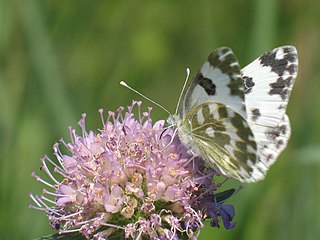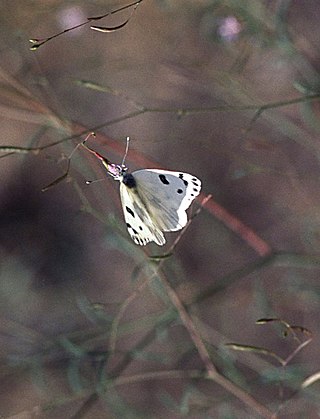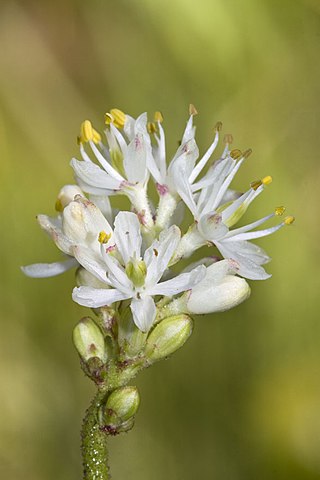
The Pieridae are a large family of butterflies with about 76 genera containing about 1,100 species, mostly from tropical Africa and tropical Asia with some varieties in the more northern regions of North America and Eurasia. Most pierid butterflies are white, yellow, or orange in coloration, often with black spots. The pigments that give the distinct coloring to these butterflies are derived from waste products in the body and are a characteristic of this family. The family was created by William John Swainson in 1820.

Pieris, the whites or garden whites, is a widespread, now almost cosmopolitan, genus of butterflies of the family Pieridae. The highest species diversity is in the Palearctic, with a higher diversity in Europe and eastern North America than the similar and closely related Pontia. The females of many Pieris butterflies are UV reflecting, while the male wings are strongly UV absorbing due to pigments in the scales.

Pontia daplidice, the Bath white, is a small butterfly of the family Pieridae, the yellows and whites, which occurs in the Palearctic region. It is common in central and southern Europe, migrating northwards every summer, often reaching southern Scandinavia and sometimes southern England.

Pontia callidice, the lofty Bath white or peak white, is a small butterfly of the yellows and whites family (Pieridae), which occurs in the Palearctic realm.

Cephalanthus occidentalis is a species of flowering plant in the family Rubiaceae that is native to eastern and southern North America. Common names include buttonbush, common buttonbush, button-willow, buck brush, and honey-bells.

Pontia is a genus of pierid butterflies. They are found in the Holarctic, but are rare in Europe and central to eastern North America, and a few species range into the Afrotropics. Several East Asian species once placed here are now more often split off in Sinopieris. Like the closely related genus Pieris, they are commonly called whites.

Pachysphinx occidentalis, the big poplar sphinx, is a moth of the family Sphingidae. The species was first described by Henry Edwards in 1875. It lives throughout Canada and the United States. The habitat consists of riparian areas and suburbs.

Pontia protodice, the checkered white or southern cabbage butterfly, is a common North American butterfly in the family Pieridae. Its green larva is a type of cabbage worm.

Melitaea didyma, the spotted fritillary or red-band fritillary, is a Palearctic butterfly of the family Nymphalidae.

Pontia edusa, the eastern Bath white, is a butterfly in the family Pieridae.

Pontia sisymbrii, the spring white, California white, or Colorado white, is a butterfly in the family Pieridae. It is found in mountainous areas of western Canada and the United States.

Pontia beckerii, the Becker's white, Great Basin white, or sagebrush white, is a butterfly in the family Pieridae. It is found in western North America from Baja California, Mexico to southern British Columbia, Canada.

Colias occidentalis, the western sulphur or golden sulphur, is a butterfly in the family Pieridae found in North America. Its range includes the Pacific Northwest and parts of British Columbia.
Pontia distorta, the small meadow white, is a butterfly in the family Pieridae. It is found in Ethiopia, Somalia, northern Kenya and possibly north-eastern Tanzania. The habitat consists of sub-desert thorn-bush areas.

Pontia glauconome, the desert white or desert Bath white, is a butterfly in the family Pieridae. It is found in Mauritania, Senegal, Gambia, Niger, Chad, Sudan, Ethiopia, Somalia, Kenya, Arabia, Kuwait, Egypt, the Middle East, Pakistan, Afghanistan, the southern part of the former Soviet Union, Uzbekistan, Tajikistan and Turkmenistan. The habitat consists of sub-deserts.

Triantha occidentalis, the western false asphodel, is a species of carnivorous flowering plant in the genus Triantha from the family Tofieldiaceae within the order of the Alismatales. It is found in the Pacific Northwest. It was recognised as a carnivorous plant in 2021, a rare occurrence within the Monocot clade.















